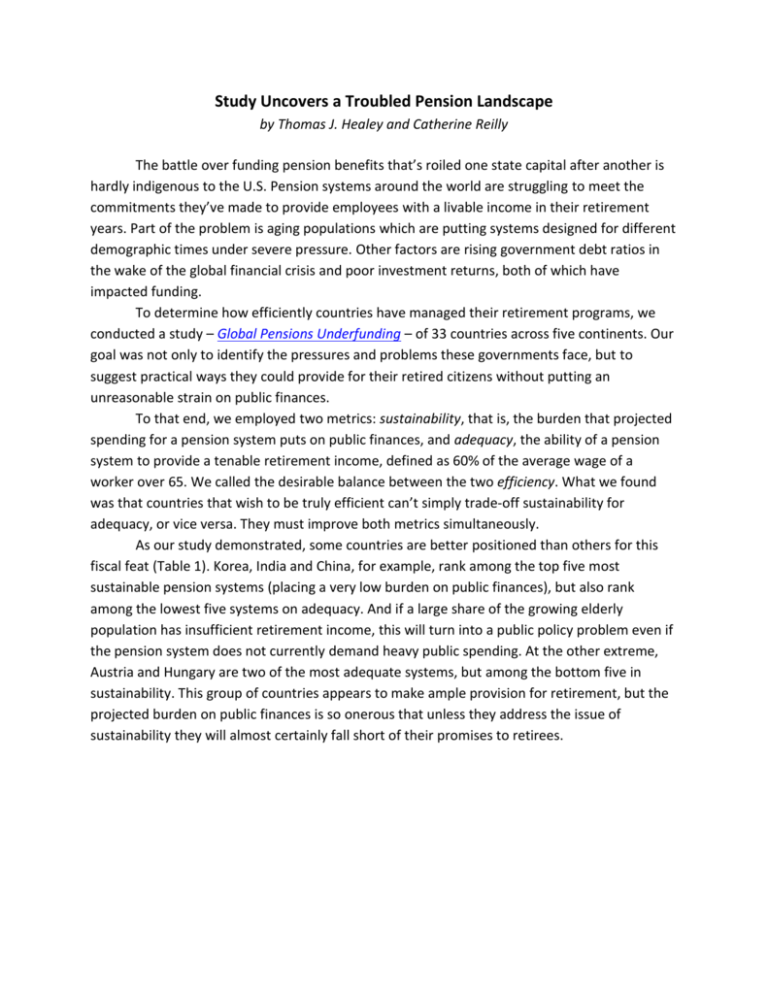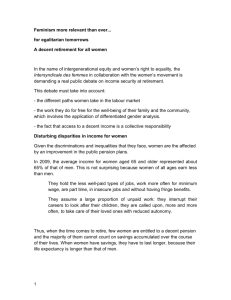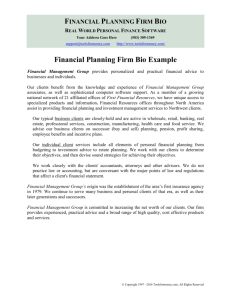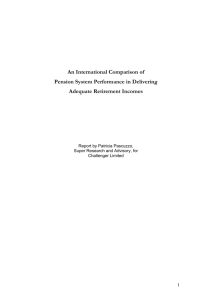Study Uncovers a Troubled Pension Landscape
advertisement

Study Uncovers a Troubled Pension Landscape by Thomas J. Healey and Catherine Reilly The battle over funding pension benefits that’s roiled one state capital after another is hardly indigenous to the U.S. Pension systems around the world are struggling to meet the commitments they’ve made to provide employees with a livable income in their retirement years. Part of the problem is aging populations which are putting systems designed for different demographic times under severe pressure. Other factors are rising government debt ratios in the wake of the global financial crisis and poor investment returns, both of which have impacted funding. To determine how efficiently countries have managed their retirement programs, we conducted a study – Global Pensions Underfunding – of 33 countries across five continents. Our goal was not only to identify the pressures and problems these governments face, but to suggest practical ways they could provide for their retired citizens without putting an unreasonable strain on public finances. To that end, we employed two metrics: sustainability, that is, the burden that projected spending for a pension system puts on public finances, and adequacy, the ability of a pension system to provide a tenable retirement income, defined as 60% of the average wage of a worker over 65. We called the desirable balance between the two efficiency. What we found was that countries that wish to be truly efficient can’t simply trade-off sustainability for adequacy, or vice versa. They must improve both metrics simultaneously. As our study demonstrated, some countries are better positioned than others for this fiscal feat (Table 1). Korea, India and China, for example, rank among the top five most sustainable pension systems (placing a very low burden on public finances), but also rank among the lowest five systems on adequacy. And if a large share of the growing elderly population has insufficient retirement income, this will turn into a public policy problem even if the pension system does not currently demand heavy public spending. At the other extreme, Austria and Hungary are two of the most adequate systems, but among the bottom five in sustainability. This group of countries appears to make ample provision for retirement, but the projected burden on public finances is so onerous that unless they address the issue of sustainability they will almost certainly fall short of their promises to retirees. 2 The U.S. falls within the “inadequate group” of nations. Despite considerable private retirement assets which put only a limited strain on public finances, it provides benefits insufficient to meet the income needs of retirees. Other members of this group include China, Mexico, India, Korea, Indonesia and Australia. Toward Greater Efficiency The most efficient group of pension managers provides decent payouts while maintaining sustainable systems to meet those obligations. Netherlands is the clear-cut leader, followed by Switzerland, the U.K., Denmark, Sweden, Poland, Estonia and the Czech and Slovak Republics. How can other countries move closer to this model? Our research and review of best practices around the world reveal a number of pathways. For countries with “overgenerous” systems -- like Belgium, Greece, Italy, France, Russia and Brazil -- a key to improving sustainability is raising the retirement age and incentivizing people to retire later (Sweden allows employees to choose their own retirement age, with no ceiling, and adjusts the pension payment accordingly). Other novel steps could include introducing a longevity coefficient into the benefit equation to limit the growth of pension expenditures (as life expectancy increases, the longevity coefficient reduces the recipient’s monthly payment). Using lifetime rather than final earnings to calculate benefits is another effective way to align payouts more closely with actual employee contributions. Countries low on the adequacy scale should aim to increase the share of population covered and/or the level of benefits to ensure sufficient income at retirement. One way to grow income is to introduce compulsory or default enrollment into a pension scheme with an adequate contribution rate. Governments should also ensure employees easy access to pension schemes which they can carry with them if they change employers. New approaches to pension system design can also help thread the needle between sustainability and adequacy. These include notional defined contribution (NDC) plans (where contributions are recorded in notional accounts, to which a rate of return, typically GDP growth, is applied), and collective defined contribution (CDC) plans (which pool contributions into a collective, centrally administered investment fund rather than individual accounts). Another way to improve efficiency is to advance fund at least some of the pension spending. Unlike typical “pay-as-you-go” plans, prefunded plans are funded concurrently with the employee’s accrued benefits so that monies are set aside well before retirement. Despite the many complexities and pitfalls of pension plan design today, it’s 3 worth noting that most countries in the “efficient group” have undergone extensive and relatively recent reforms. Sweden and Denmark, for instance, have introduced NDC and CDC schemes, while the U.K. and Poland have expanded their direct contribution systems. Laudably, these countries have designed or re-tooled pension systems to reflect their current demographic profiles, while incorporating best practices from other systems globally. They should serve as a beacon of encouragement for governments everywhere faced with inadequate pension programs in desperate need of change. Table 1. Top and bottom scoring countries on “sustainability” and “adequacy” Sustainability Index Adequacy Index Country Score Country Score Top five Korea 82 Luxembourg 97 Australia 75 Russia 83 India 74 Hungary 74 Indonesia 72 Netherlands 74 China 70 Austria 67 Bottom five Italy Austria Greece Hungary Belgium 12 11 10 9 9 Germany China Mexico Korea India 30 22 20 4 2 ____________ Tom Healey is a Senior Fellow of the Mossavar-Rahmani Center for Business and Government. Catherine Reilly is currently pursuing her MPA studies at the Harvard Kennedy School of Government, with a particular interest in pensions and behavioral economics.





